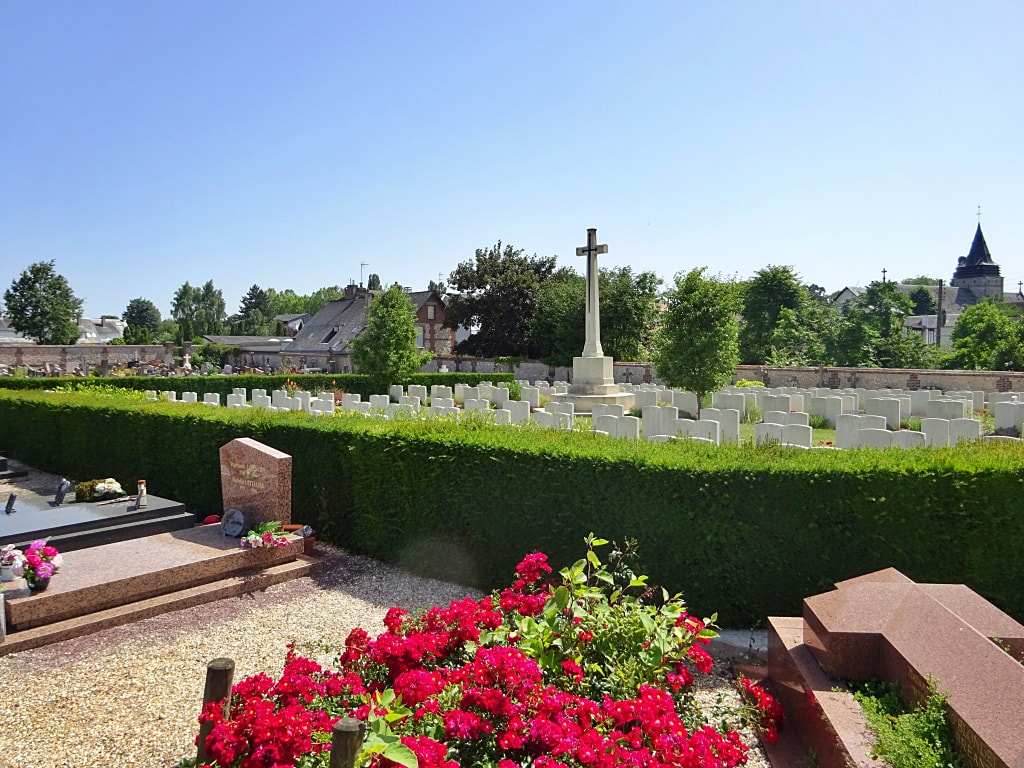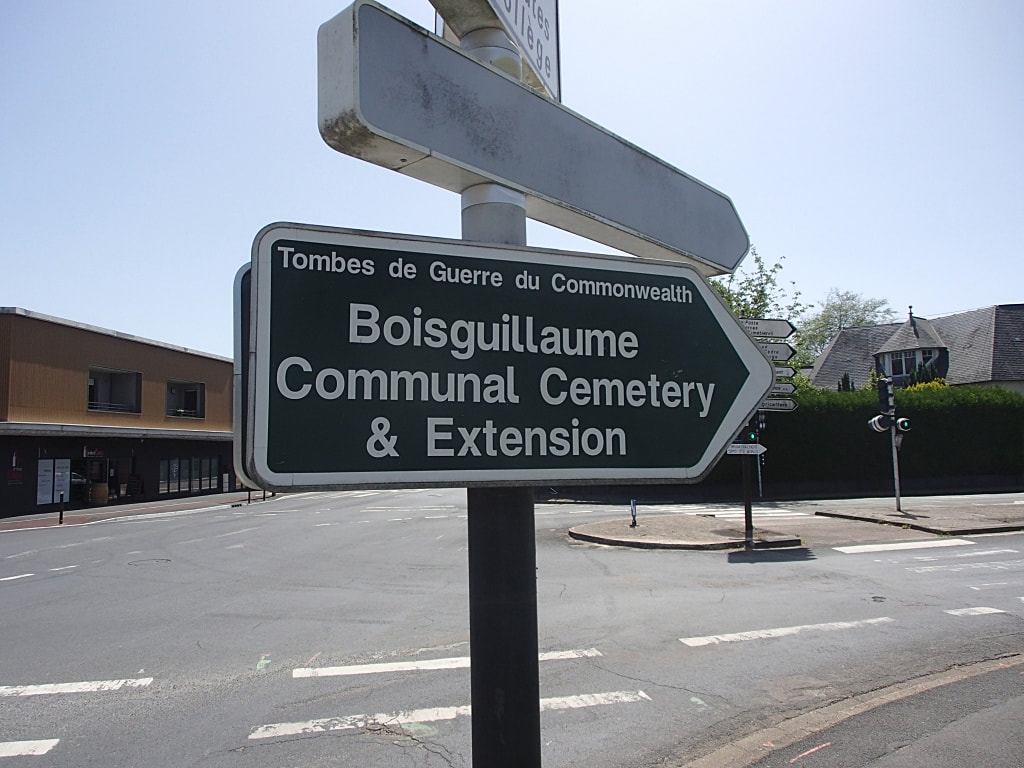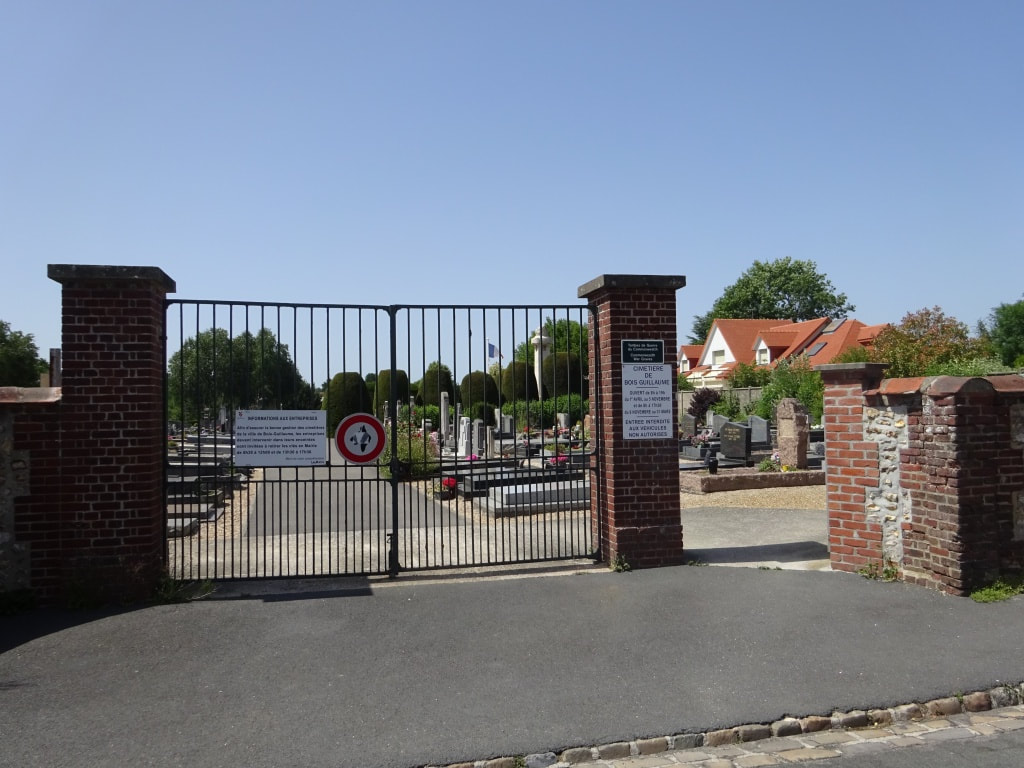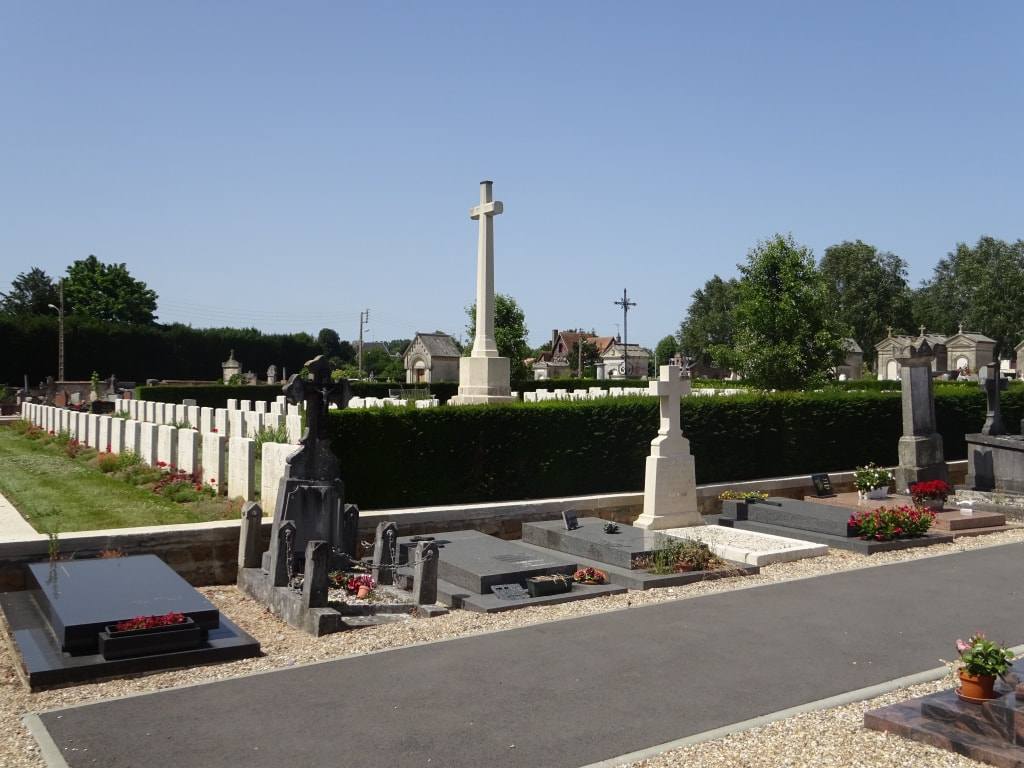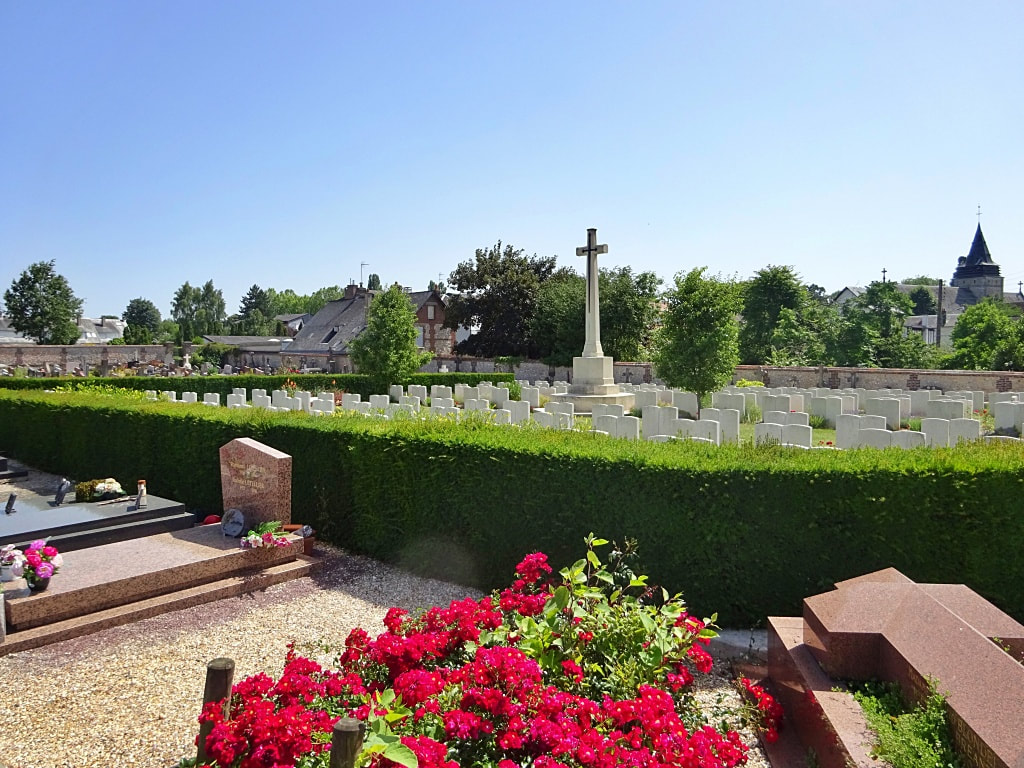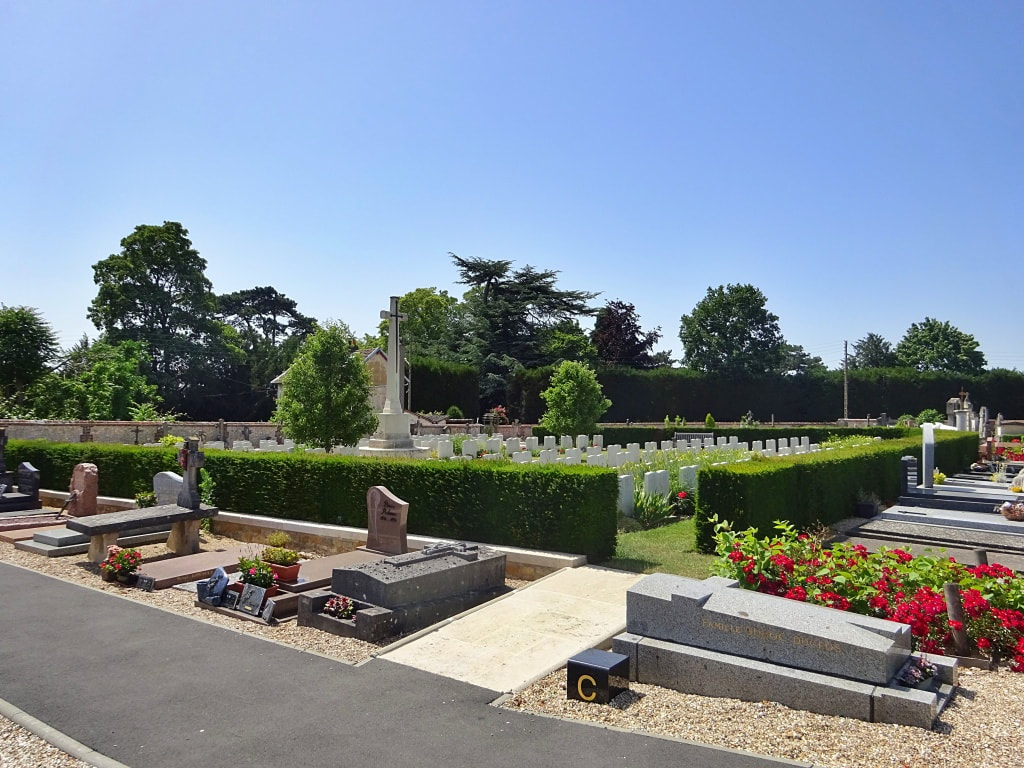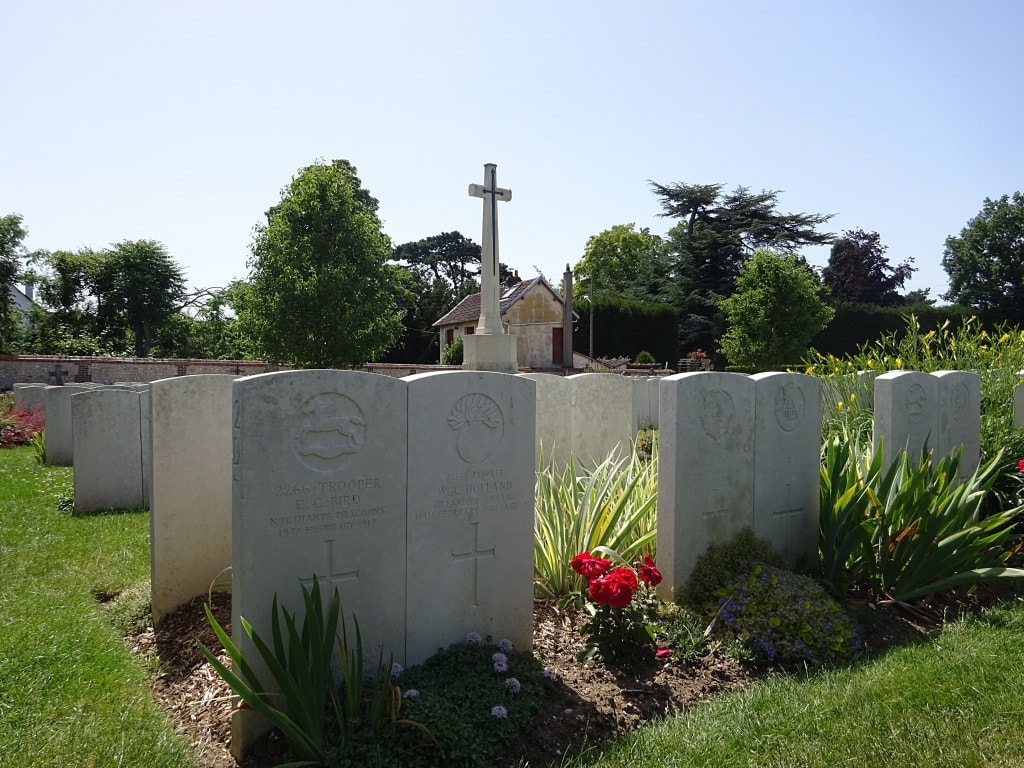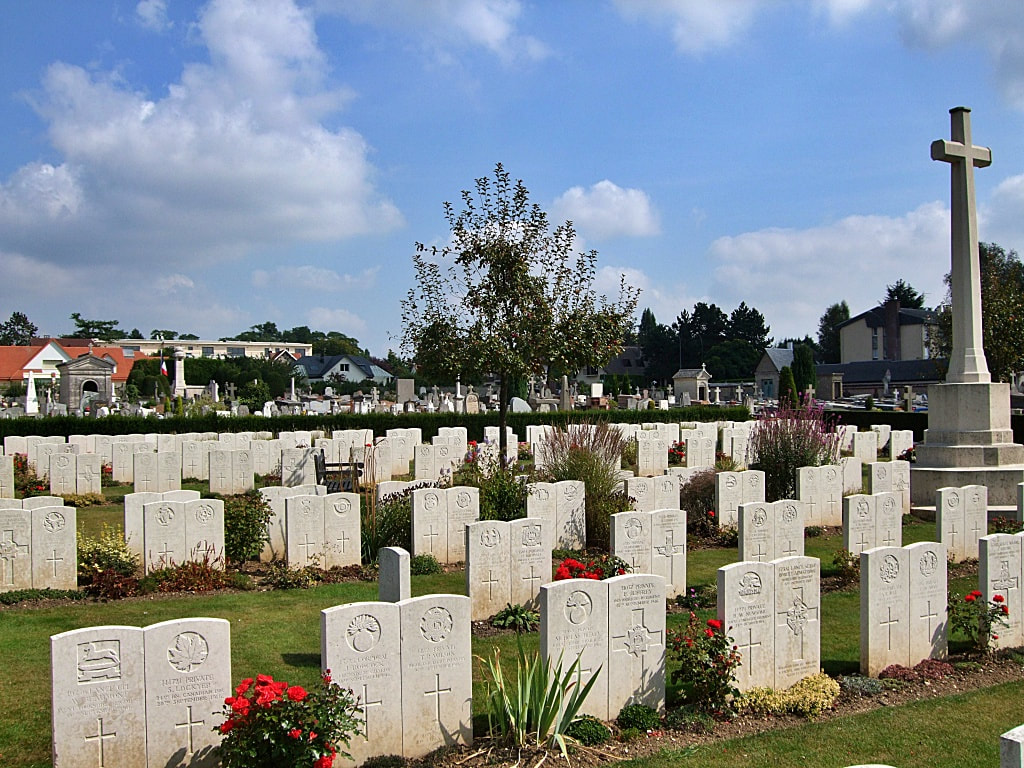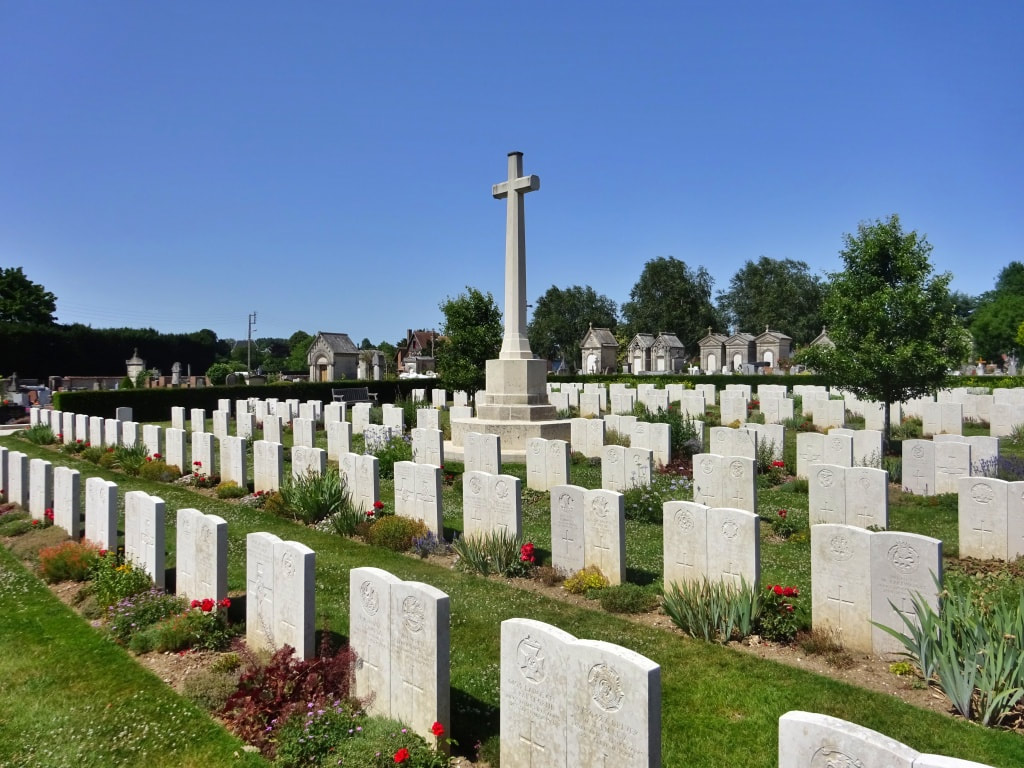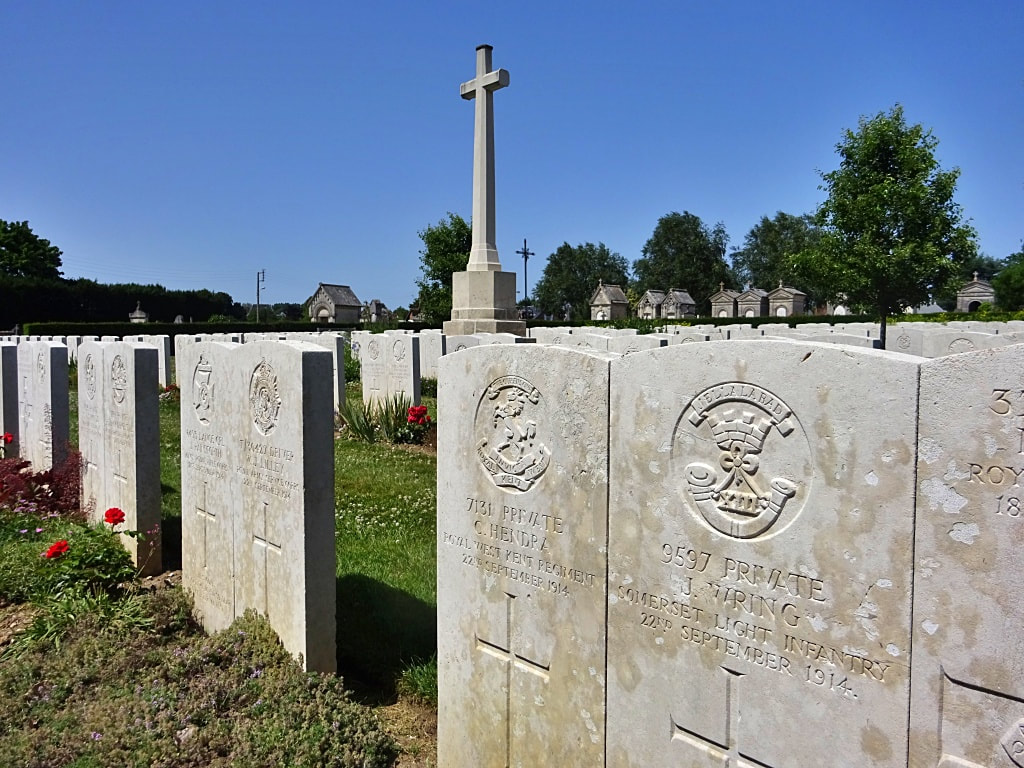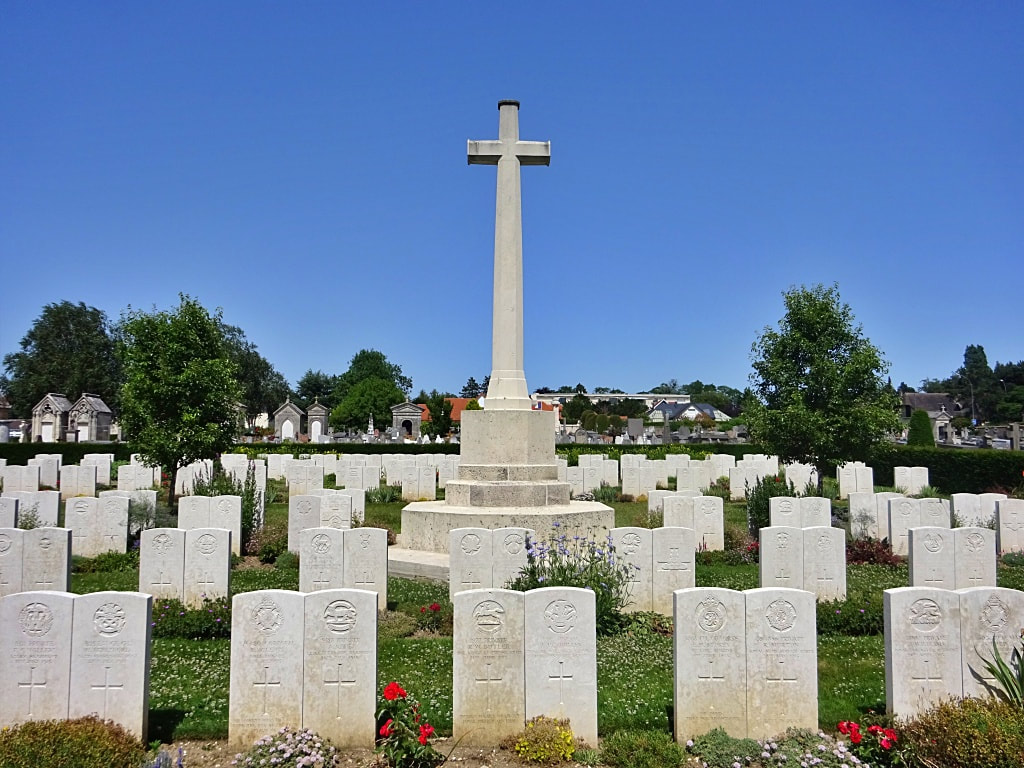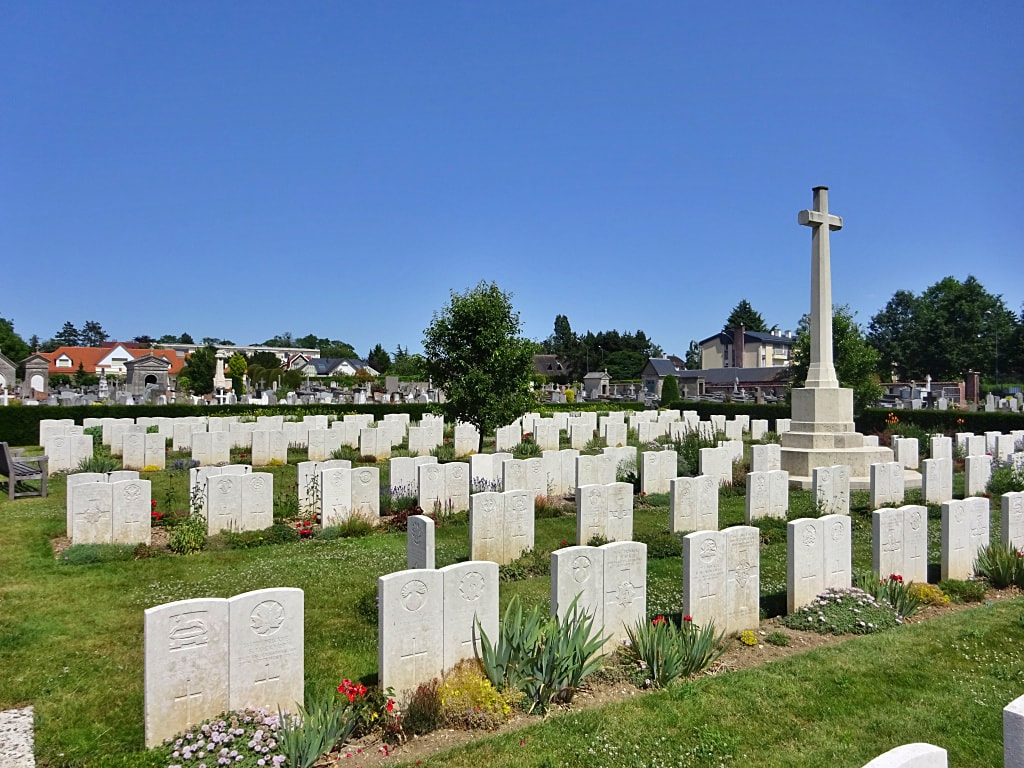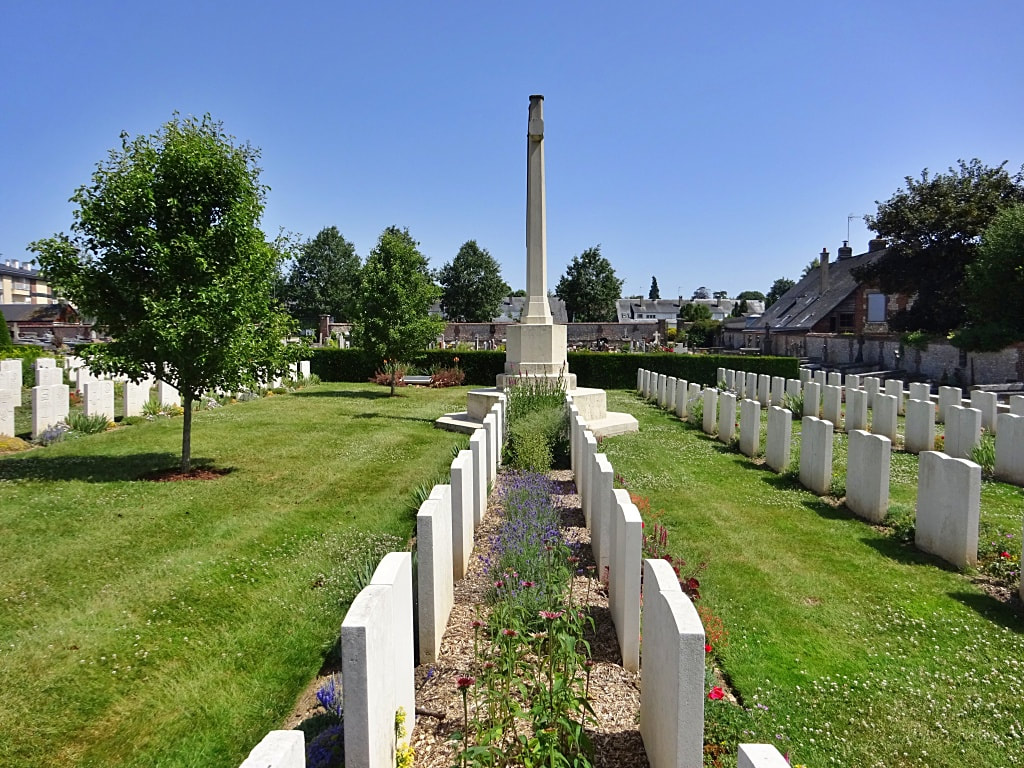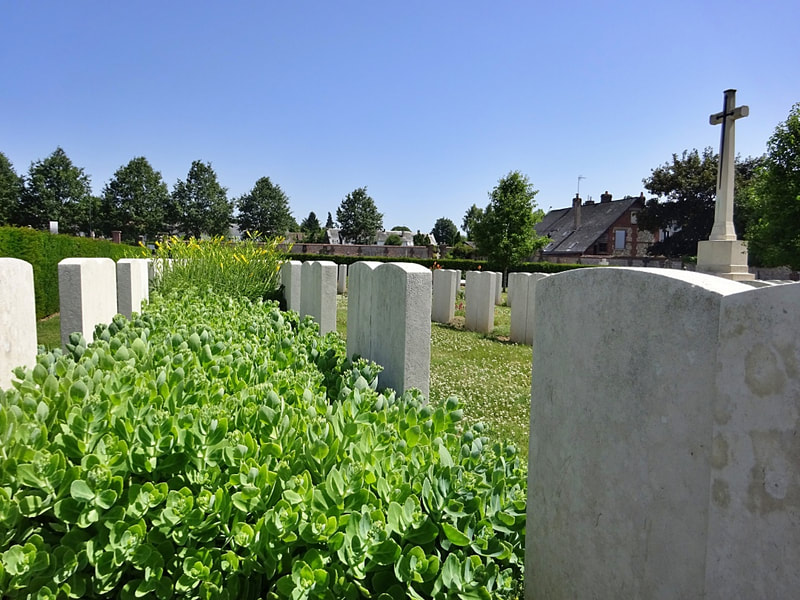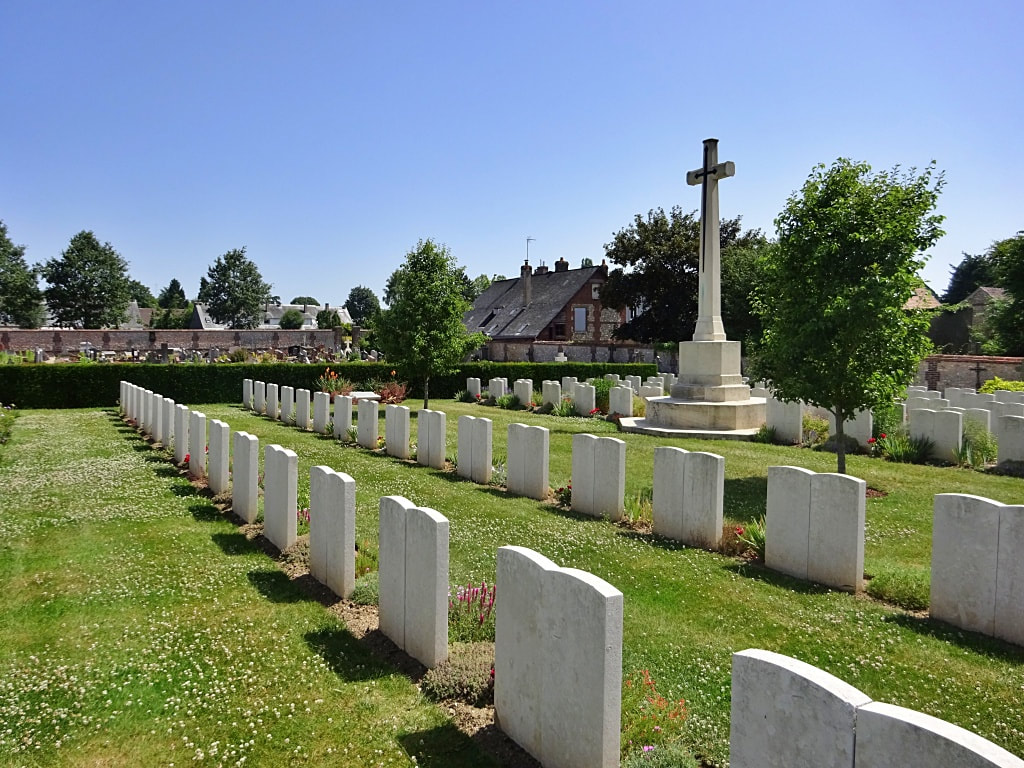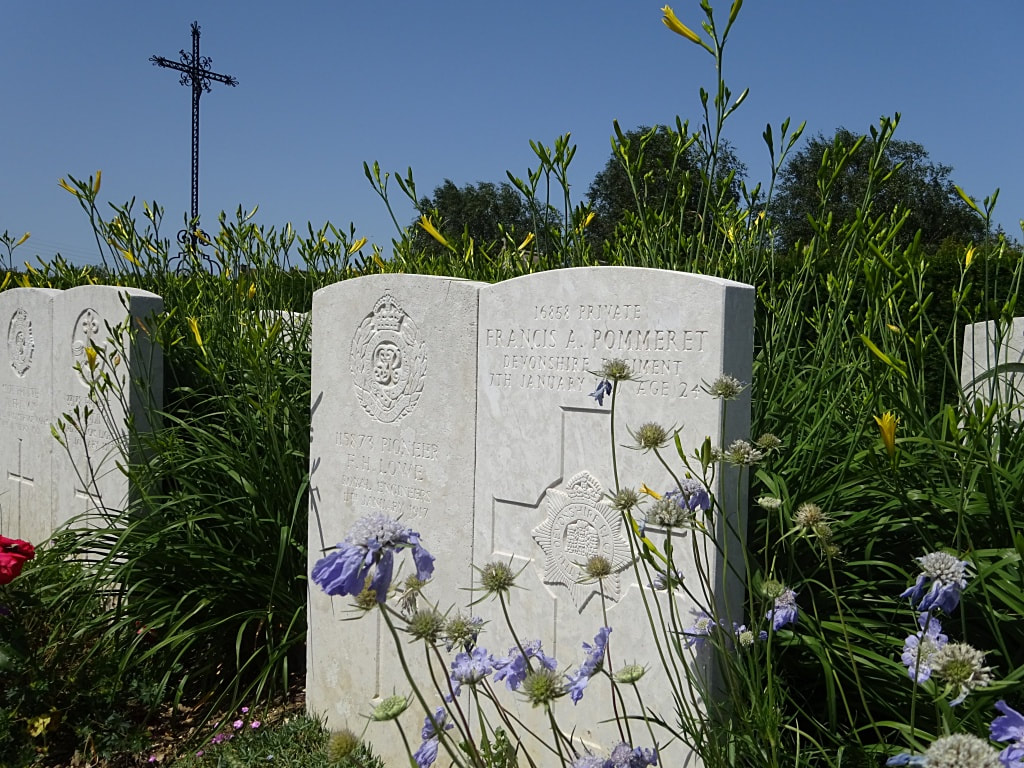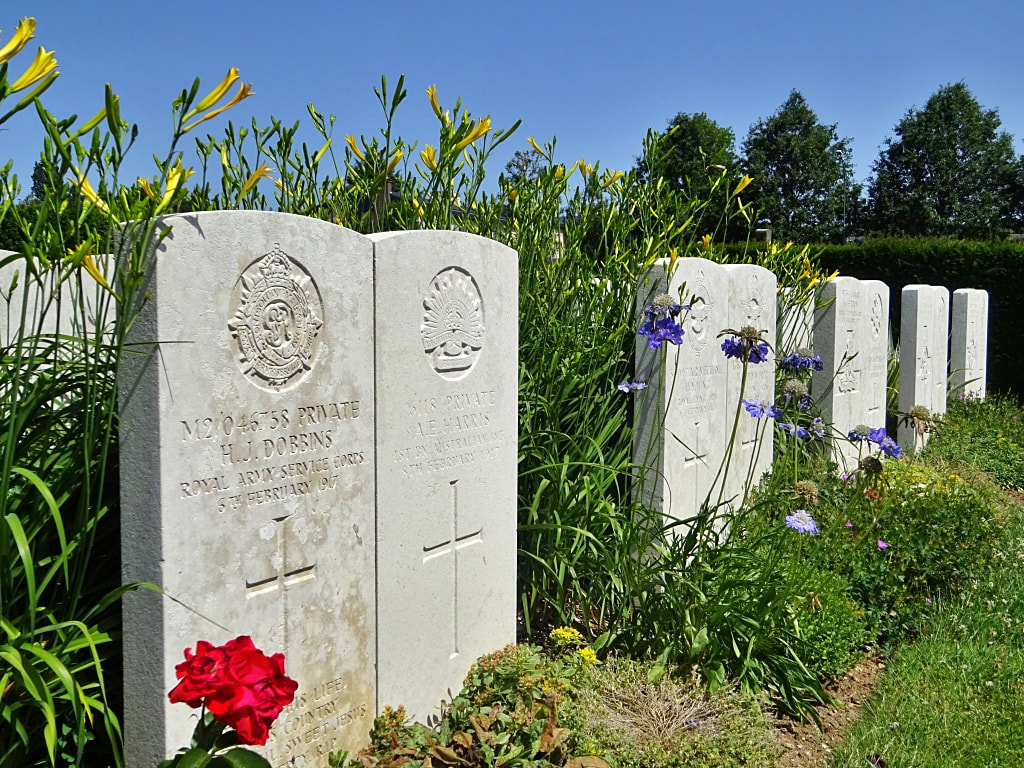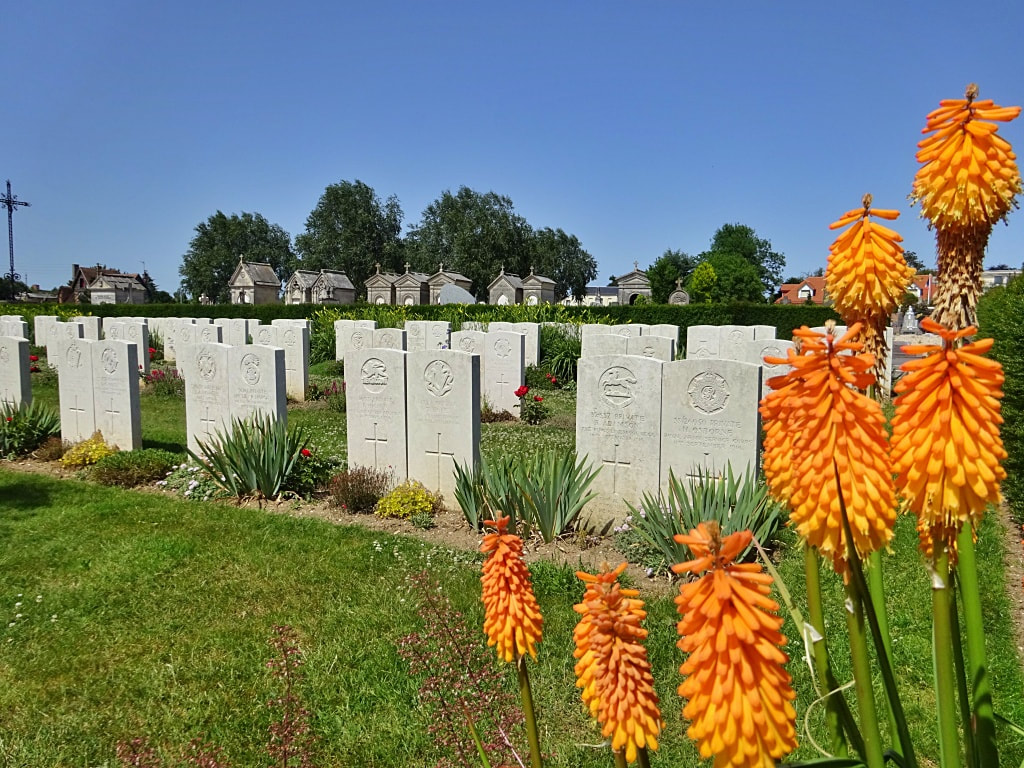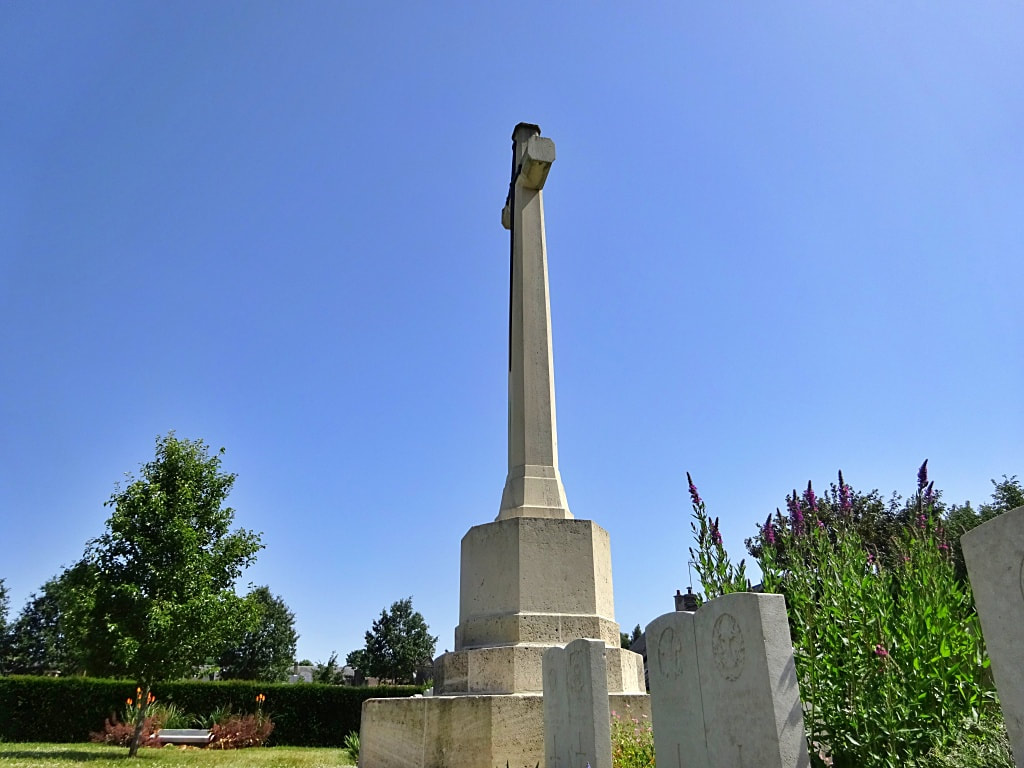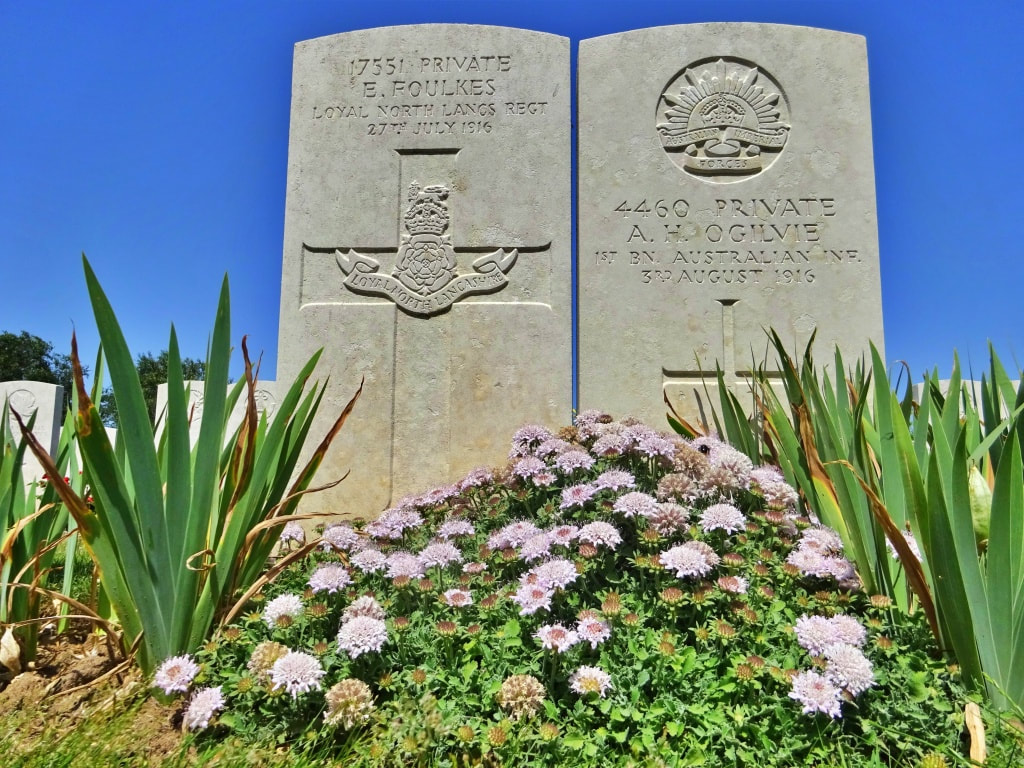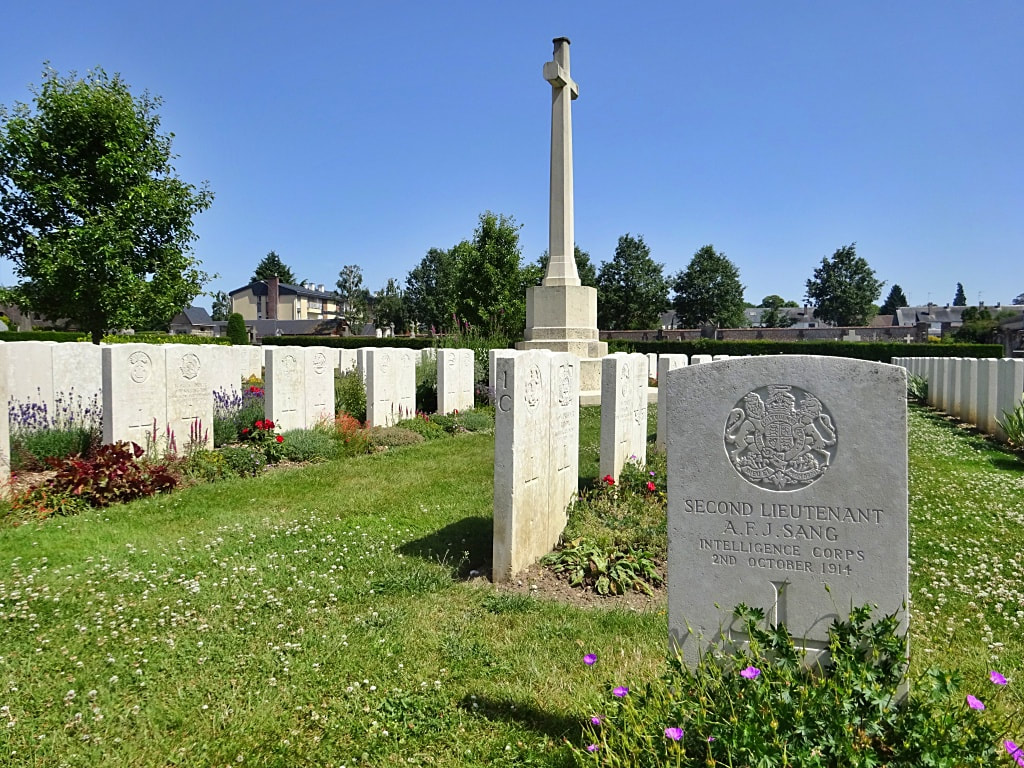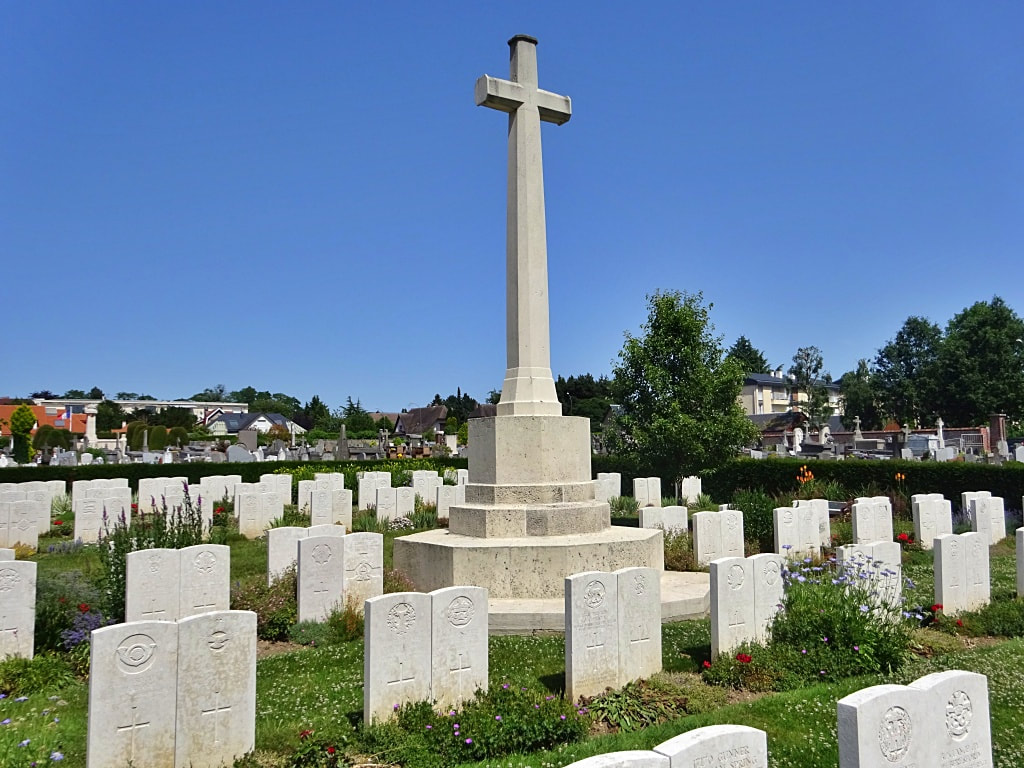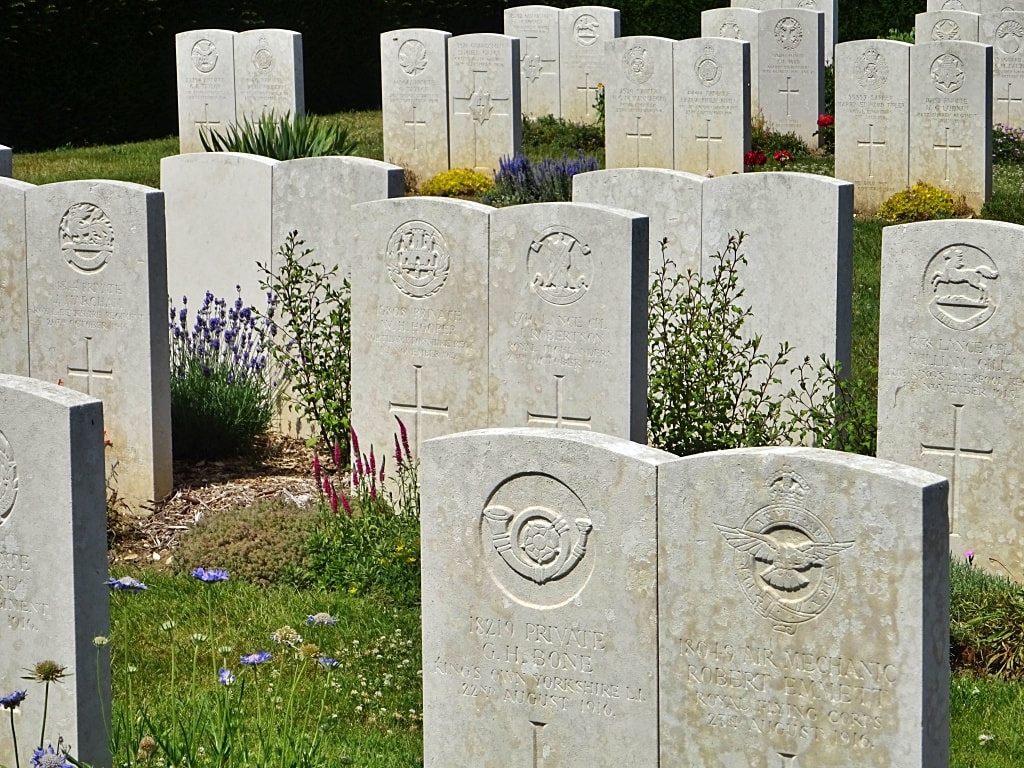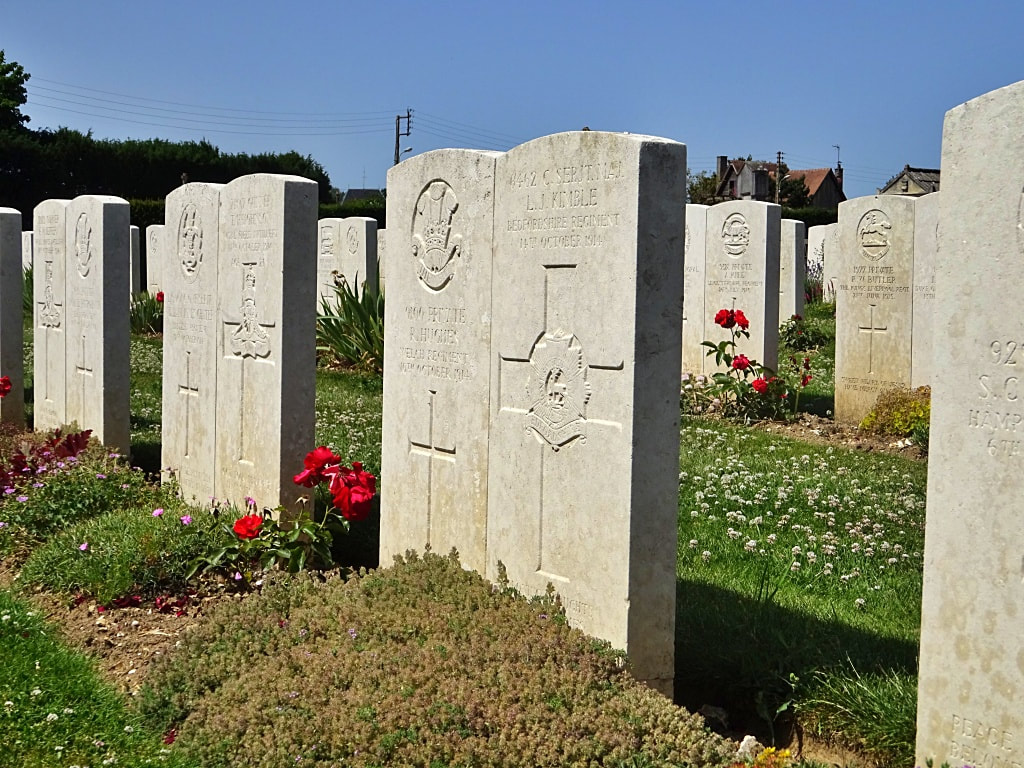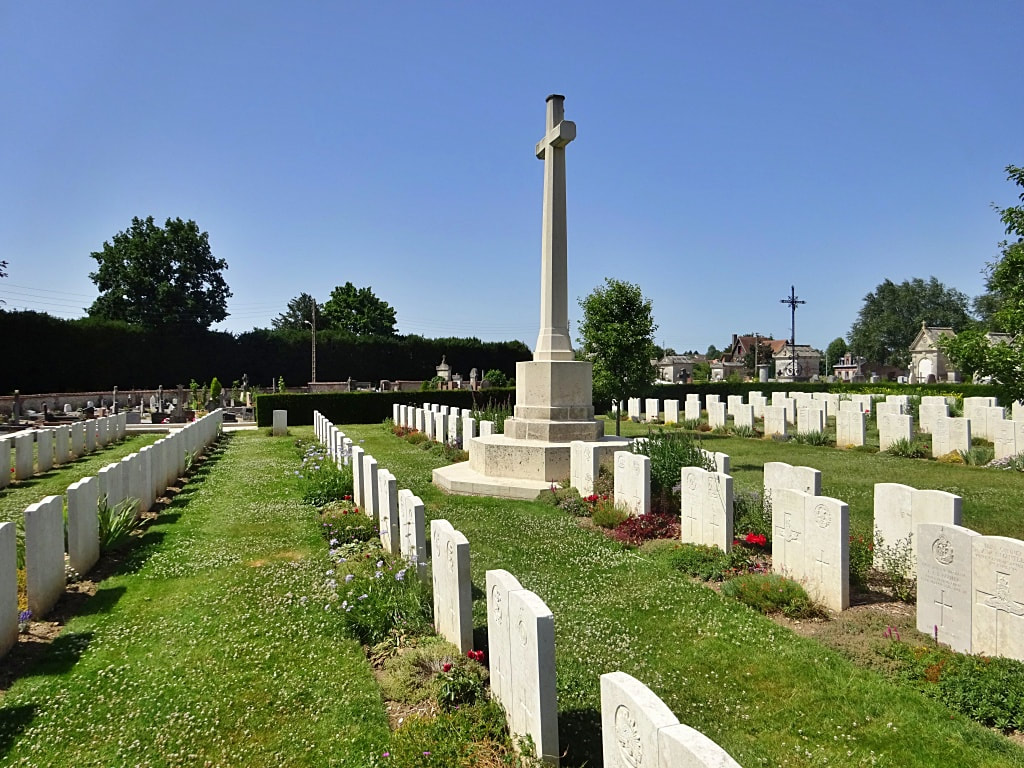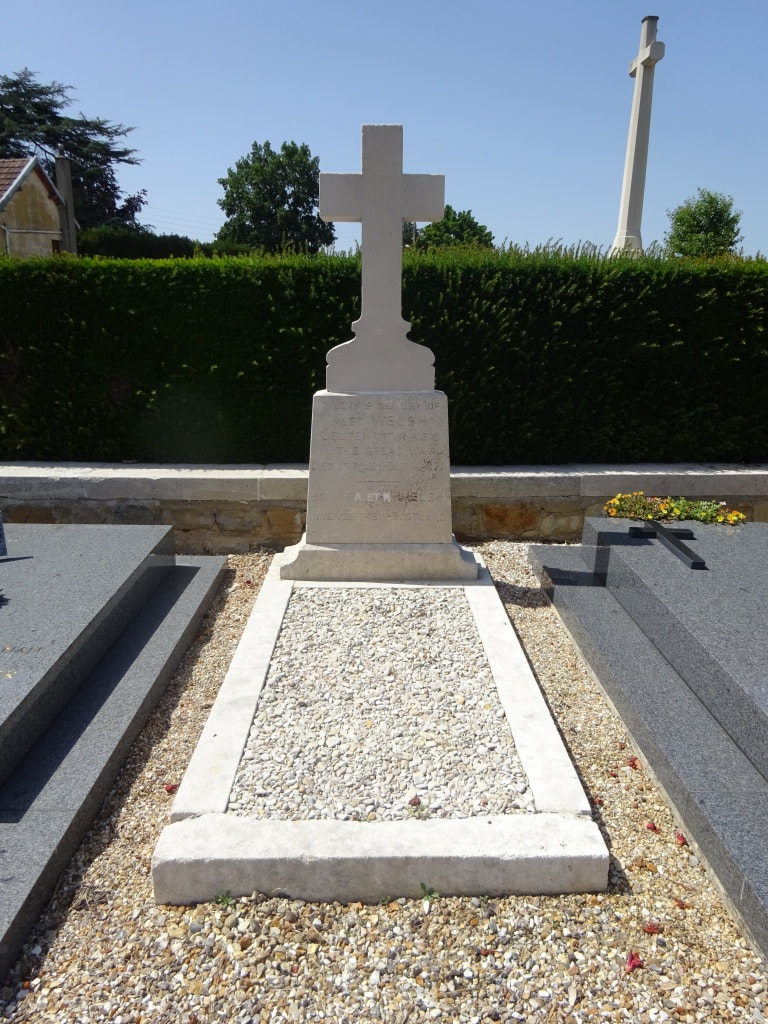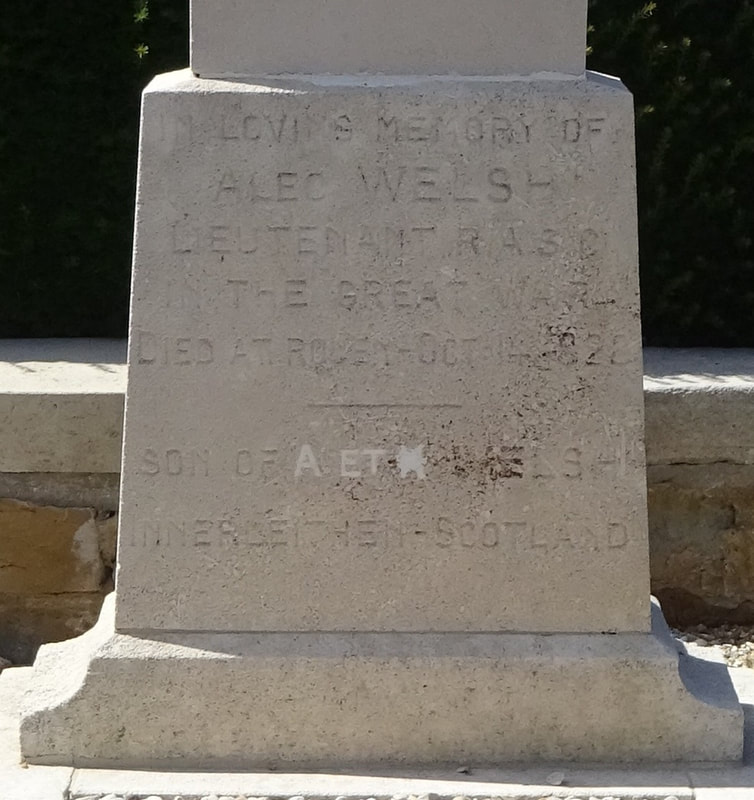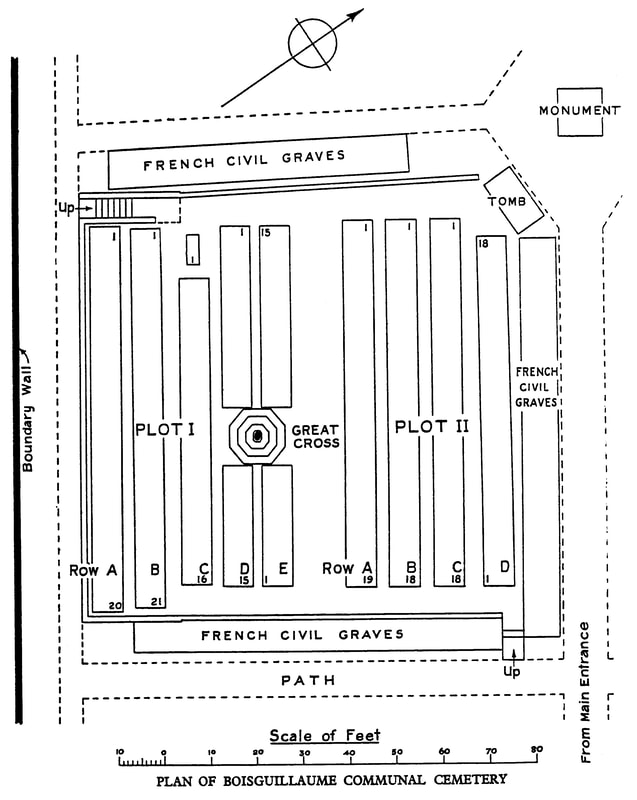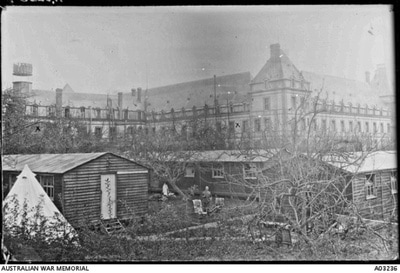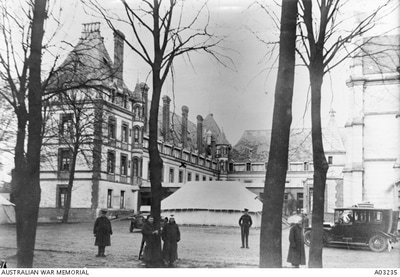BOIS-GUILLAUME COMMUNAL CEMETERY
Seine-Maritime
France
GPS Coordinates: Latitude: 49.46912, Longitude: 1.11193
Location Information
Bois-Guillaume is a north-eastern suburb of Rouen, on the main road to Neufchatel.
A CWGC signpost is on the road (D928) to Neufchatel at the street corner near the Mairie (Town Hall). Turn left here, and then take the second left into the Rue de la Mare des Champs. The Cemetery is on the right hand side of the road. Locally, the Communal Cemetery is known as the Cimitere de la Mare des Champs.
Visiting Information
Wheelchair access with some difficulty.
Historical Information
The two plots in the communal cemetery, which were reserved for Commonwealth burials from September 1914 to March 1917, contain 160 double graves. These plots are on the south side of the central French monument, surrounded by civilian graves and raised above the level of the cemetery.
The burials took place, for the most part, from No.8 General Hospital, which was quartered at Bois-Guillaume in a large private house and grounds. Plot II also contains the graves of servicemen killed in a railway accident on the 14th February 1917. From March 1917, burials were made in the adjoining cemetery extension.
The communal cemetery contains 320 Commonwealth burials of the First World War. The extension contains a further 361 First World War graves and one from the Second World War.
The commonwealth plot was designed by Sir Reginald Blomfield and Captain William Clement Von Berg, M. C.
Identified Casualties: United Kingdom 302, Australia 10, Canada 6, South Africa 2. Total 320
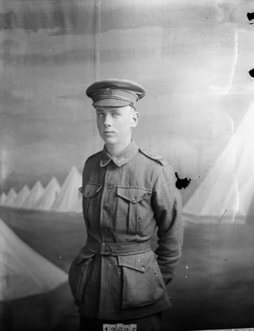
4500 Private
Tasman Gallagher
52nd Bn. Australian Infantry, A. I. F.
5th December 1916, aged 18.
Plot I. C. 16.
Inscription "We Do Not Count As Lost This Life So Freely Given"
Son of Peter John and Louisa Jane Gallagher, of Franklin, Huon, Tasmania.
Studio portrait of 4500 Private (Pte) Tasman Gallagher, 14th Reinforcements, 12th Battalion, of Franklin, Tas. Pte Gallagher enlisted on 7 December 1915 and embarked aboard HMAT Warilda on 8 February 1916. Pte Gallagher was wounded three times, at Pozieres, Mouquet Farm and Amiens. On 6 December 1916, aged eighteen years and four months, he died of nephritis at Rouen, France.
Tasman Gallagher
52nd Bn. Australian Infantry, A. I. F.
5th December 1916, aged 18.
Plot I. C. 16.
Inscription "We Do Not Count As Lost This Life So Freely Given"
Son of Peter John and Louisa Jane Gallagher, of Franklin, Huon, Tasmania.
Studio portrait of 4500 Private (Pte) Tasman Gallagher, 14th Reinforcements, 12th Battalion, of Franklin, Tas. Pte Gallagher enlisted on 7 December 1915 and embarked aboard HMAT Warilda on 8 February 1916. Pte Gallagher was wounded three times, at Pozieres, Mouquet Farm and Amiens. On 6 December 1916, aged eighteen years and four months, he died of nephritis at Rouen, France.

T/30427 Driver
William John Lilley
Army Service Corps attd. 7th Field Amb. Royal Army Medical Corps
22nd September 1914, aged 25.
Plot I. A. 19A.
Son of Mr. and Mrs. Lilley, of Derby; husband of Mrs. C. M. Lilley, of 10, River Street, River, Dover.
William John Lilley
Army Service Corps attd. 7th Field Amb. Royal Army Medical Corps
22nd September 1914, aged 25.
Plot I. A. 19A.
Son of Mr. and Mrs. Lilley, of Derby; husband of Mrs. C. M. Lilley, of 10, River Street, River, Dover.
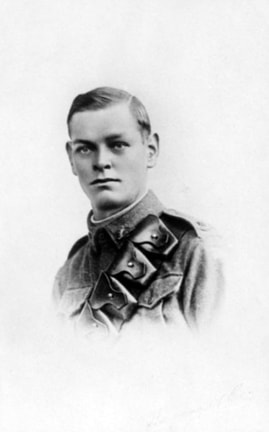
2093 Driver
Charles Maurice Mackie
1st Div. Ammunition Col. Australian Field Artillery
13th January 1917, aged 21.
Plot II. C. 7A.
Son of George William and Elizabeth Mackie, of Orangeville, via Camden, New South Wales.
Studio portrait of 2093 Driver (Dvr) Charles Maurice Mackie, Australian Field Artillery (AFA) from Prospect, South Australia. A 19 year old presser and machinist with prior service with the 34th Battery AFA Militia, he enlisted on 19 August 1914. He embarked for overseas with the 3rd Field Artillery Brigade Ammunition Column from Adelaide on 20 October 1914 aboard HMAT Medic (A7). While serving at Gallipoli, he was taken ill and evacuated to Mudros on 8 December 1915. On recovery, he rejoined his unit in Egypt in January and proceeded to France with them in March 1916. Six months after transferring to the 1st Divisional Ammunition Column, he was taken ill and hospitalised. Dvr Mackie died of a cerebral tumour on 13 January 1917 and was buried in the Boise Guillaume Communal Cemetery, France. According to his mother, "he was one of the first five boys to hand in his name to his Captain of the Battery for voluntary services on the morning that war was declared".
Charles Maurice Mackie
1st Div. Ammunition Col. Australian Field Artillery
13th January 1917, aged 21.
Plot II. C. 7A.
Son of George William and Elizabeth Mackie, of Orangeville, via Camden, New South Wales.
Studio portrait of 2093 Driver (Dvr) Charles Maurice Mackie, Australian Field Artillery (AFA) from Prospect, South Australia. A 19 year old presser and machinist with prior service with the 34th Battery AFA Militia, he enlisted on 19 August 1914. He embarked for overseas with the 3rd Field Artillery Brigade Ammunition Column from Adelaide on 20 October 1914 aboard HMAT Medic (A7). While serving at Gallipoli, he was taken ill and evacuated to Mudros on 8 December 1915. On recovery, he rejoined his unit in Egypt in January and proceeded to France with them in March 1916. Six months after transferring to the 1st Divisional Ammunition Column, he was taken ill and hospitalised. Dvr Mackie died of a cerebral tumour on 13 January 1917 and was buried in the Boise Guillaume Communal Cemetery, France. According to his mother, "he was one of the first five boys to hand in his name to his Captain of the Battery for voluntary services on the morning that war was declared".
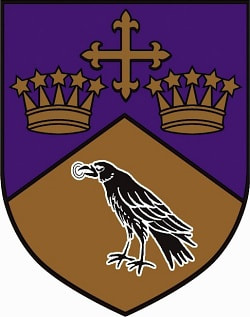
T4/036384 Driver
George Forrester Naginton
99th Horse Transport Company, Army Service Corps
19th October 1915, aged 41.
Plot I. D. 4A.
Son of George and Eliza Nagington, of Mill House, Penkridge, Staffs.
His headstone bears the inscription "I Called Upon Thee Thou Saidst, Fear Not Lam. III Ver. 57"
The information below supplied by 'The Ellesmerian Club', the alumni organisation for Ellesmere College where George was a pupil.
George Forrester Naginton
99th Horse Transport Company, Army Service Corps
19th October 1915, aged 41.
Plot I. D. 4A.
Son of George and Eliza Nagington, of Mill House, Penkridge, Staffs.
His headstone bears the inscription "I Called Upon Thee Thou Saidst, Fear Not Lam. III Ver. 57"
The information below supplied by 'The Ellesmerian Club', the alumni organisation for Ellesmere College where George was a pupil.
George Forrester Nagington was born on 6th November 1873, the son of George, a miller and his wife, Eliza who lived at Penkridge, Staffordshire. His mother died in 1880 and his father remarried to Alice Annie Gripton in 1882.
George was admitted to Ellesmere College on 13th May 1886 and stayed until July 1888. He was one of eighteen new boys that term and would have made friends with another direct contemporary, Reginald Woodcock, who also lost his life in the Great War. He was initially placed in Form Lower I under the tutelage of Mr. W. T. Skene.
His career at Ellesmere was an unremarkable one. He represented the ‘Gordon’ dormitory at cricket and failed (like seven other members of the team) to score a run in the match against the ‘King Alfred’ dormitory on 23rdJuly 1888. He could, at least, claim he was the ‘not out’ batsman. He contributed seven shillings (thirty-five pence in modern coinage!) to the Cricket Field Fund. (The field was being levelled by the labour of the staff and boys in the early days of college and cash was required for the hire of horses, etc.) He was awarded his swimming certificate in the summer of 1887 for swimming fifty yards in Whitemere – the college swimming pool at this time in its development.
After leaving Ellesmere, George worked for his father as a miller’s assistant at Penkridge Mill, but what happened to him from 1891 to 1914 is a mystery. His father died in May 1907, and his two sisters had married. It is possible that he went to live with his sister, Lucy Ann, in the Egremont area of Cheshire. In his Attestation Papers, signed on 27th November 1914, he gave his occupation as gardener and his age as thirty-three years old. He was in fact eight years older and was one of the many men who lied about their age in order to serve their country. He was 5 feet 6 inches tall (1.65m) and weighed 140 pounds (64kg).
George was initially placed in a territorial unit, the Hampshire Brigade Company, the Army Service Corps, when he first joined up on 1st September 1914 but was transferred to the regular army on 26th November and his military service dates from then. He was in the 99th Horse Transport Company, the A.S.C. After his training, he was sent to France on 21st March 1915. From then until October he served with various regular units keeping them supplied with food and ammunition.
On 5th October 1915, he was “committed” to Hospital suffering from influenza. Nine days later he was moved to No. 11 Stationary Hospital, with Gastro-Duodenal Catarrh. He was now dangerously ill and taken to No. 8 General Hospital, Rouen. His medical case sheet says that he was “in a state of acute prostration with confusion of thought”. On 18th, “he was very weak with muttering delirium.” George was given “brandy and strychnine 1/80 gr” but he did not respond and died at 0800 on 19th October – one of 290 Allied servicemen who lost their lives that day. The official cause of death was given as septicaemia
George was buried at Bois Guillaume Communal Cemetery, Rouen and his life is commemorated on the memorials at Penkridge and Ellesmere College.
George’s effects and medals, the 1914-1915 Star, the British War Medal and the Victory Medal were left to his sister, Lucy Ann.
George was admitted to Ellesmere College on 13th May 1886 and stayed until July 1888. He was one of eighteen new boys that term and would have made friends with another direct contemporary, Reginald Woodcock, who also lost his life in the Great War. He was initially placed in Form Lower I under the tutelage of Mr. W. T. Skene.
His career at Ellesmere was an unremarkable one. He represented the ‘Gordon’ dormitory at cricket and failed (like seven other members of the team) to score a run in the match against the ‘King Alfred’ dormitory on 23rdJuly 1888. He could, at least, claim he was the ‘not out’ batsman. He contributed seven shillings (thirty-five pence in modern coinage!) to the Cricket Field Fund. (The field was being levelled by the labour of the staff and boys in the early days of college and cash was required for the hire of horses, etc.) He was awarded his swimming certificate in the summer of 1887 for swimming fifty yards in Whitemere – the college swimming pool at this time in its development.
After leaving Ellesmere, George worked for his father as a miller’s assistant at Penkridge Mill, but what happened to him from 1891 to 1914 is a mystery. His father died in May 1907, and his two sisters had married. It is possible that he went to live with his sister, Lucy Ann, in the Egremont area of Cheshire. In his Attestation Papers, signed on 27th November 1914, he gave his occupation as gardener and his age as thirty-three years old. He was in fact eight years older and was one of the many men who lied about their age in order to serve their country. He was 5 feet 6 inches tall (1.65m) and weighed 140 pounds (64kg).
George was initially placed in a territorial unit, the Hampshire Brigade Company, the Army Service Corps, when he first joined up on 1st September 1914 but was transferred to the regular army on 26th November and his military service dates from then. He was in the 99th Horse Transport Company, the A.S.C. After his training, he was sent to France on 21st March 1915. From then until October he served with various regular units keeping them supplied with food and ammunition.
On 5th October 1915, he was “committed” to Hospital suffering from influenza. Nine days later he was moved to No. 11 Stationary Hospital, with Gastro-Duodenal Catarrh. He was now dangerously ill and taken to No. 8 General Hospital, Rouen. His medical case sheet says that he was “in a state of acute prostration with confusion of thought”. On 18th, “he was very weak with muttering delirium.” George was given “brandy and strychnine 1/80 gr” but he did not respond and died at 0800 on 19th October – one of 290 Allied servicemen who lost their lives that day. The official cause of death was given as septicaemia
George was buried at Bois Guillaume Communal Cemetery, Rouen and his life is commemorated on the memorials at Penkridge and Ellesmere College.
George’s effects and medals, the 1914-1915 Star, the British War Medal and the Victory Medal were left to his sister, Lucy Ann.
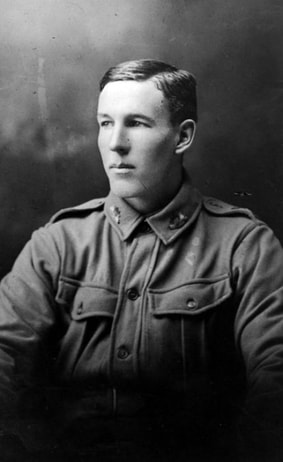
1359 Corporal
Harold John Niven
19th Bn. Australian Infantry, A. I. F.
14th February 1917, aged 23.
Plot II. D. 11A.
Inscription "Not Life Itself But Boyhood's Dreams I Lose That You May Live"
Son of Alexander and Jane Niven, of 16, Hawthorn Road, Caulfield, Melbourne, Victoria, Australia.
A 21 year old orchardist prior to enlistment on 2 April 1915, he embarked for overseas with the Transport Section from Sydney on 6 July 1915 aboard SS Hobart. While serving on the Western Front, he was promoted to Temporary Corporal on 6 January 1917 and then accidentally killed in a railway accident on 14 February 1917.
Harold John Niven
19th Bn. Australian Infantry, A. I. F.
14th February 1917, aged 23.
Plot II. D. 11A.
Inscription "Not Life Itself But Boyhood's Dreams I Lose That You May Live"
Son of Alexander and Jane Niven, of 16, Hawthorn Road, Caulfield, Melbourne, Victoria, Australia.
A 21 year old orchardist prior to enlistment on 2 April 1915, he embarked for overseas with the Transport Section from Sydney on 6 July 1915 aboard SS Hobart. While serving on the Western Front, he was promoted to Temporary Corporal on 6 January 1917 and then accidentally killed in a railway accident on 14 February 1917.
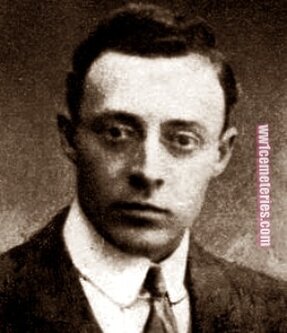
Second Lieutenant
Alfred Frederick Joseph Sang
Intelligence Corps
2nd October 1914, aged 38.
Plot I. C. 1.
Son of Frederick J. and Caroline Jane Garth Sang; born in Paris; husband of Sara A. Sang, of 182, Park Street, Canandaigua, New York, U.S.A.
Alfred Frederick Joseph Sang
Intelligence Corps
2nd October 1914, aged 38.
Plot I. C. 1.
Son of Frederick J. and Caroline Jane Garth Sang; born in Paris; husband of Sara A. Sang, of 182, Park Street, Canandaigua, New York, U.S.A.

